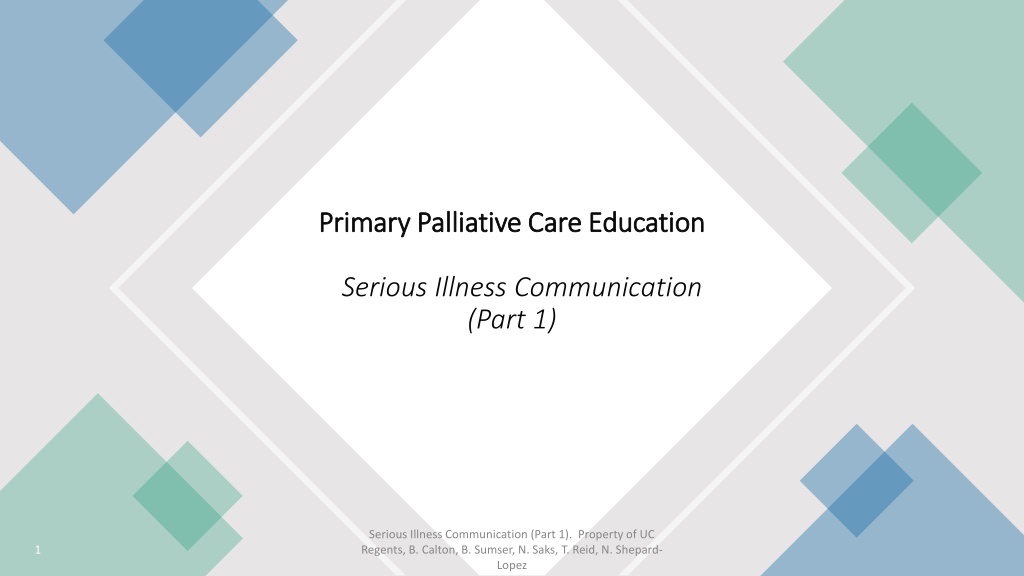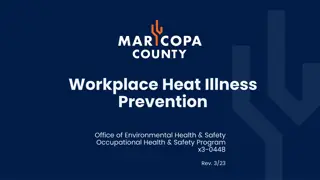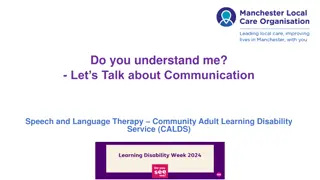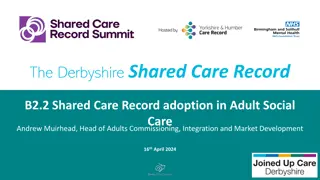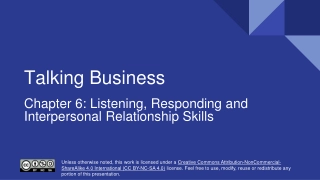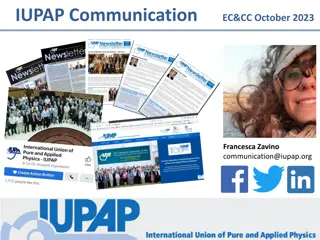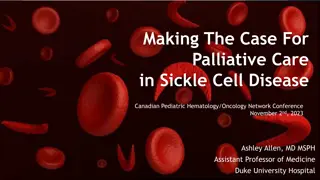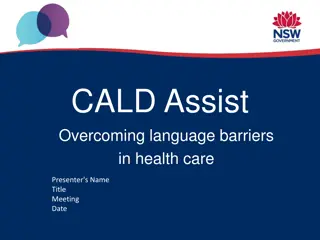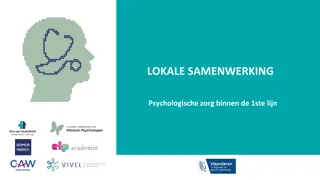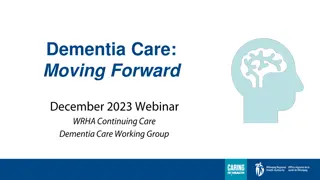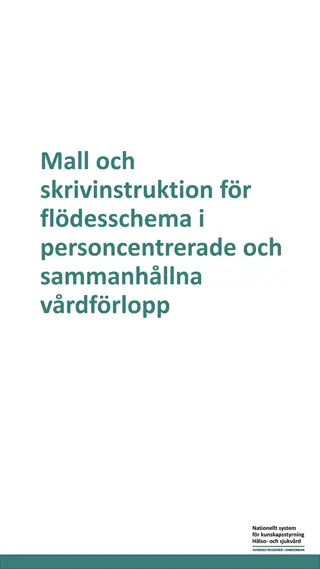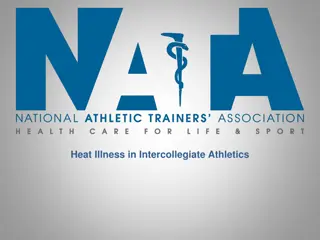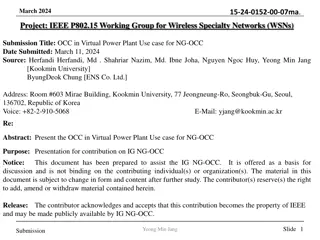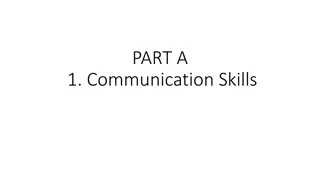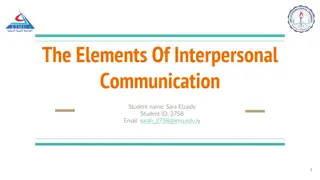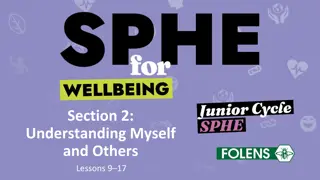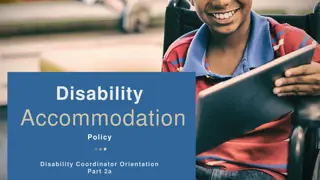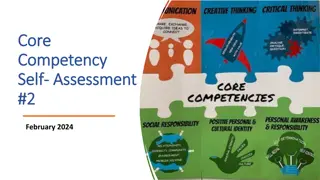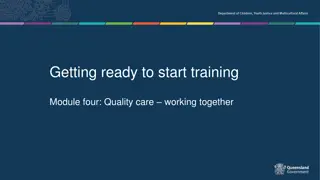Enhancing Communication in Serious Illness Care
Explore best practices and skills for effective communication with seriously ill patients and their families. Learn about guiding principles and the impact of self-efficacy on job satisfaction in palliative care settings. Understand the importance of concordance between patient wishes and care received, as well as the benefits of improved communication skills in this context.
Download Presentation
Please find below an Image/Link to download the presentation.
The content on the website is provided AS IS for your information and personal use only. It may not be sold, licensed, or shared on other websites without obtaining consent from the author. Download presentation by click this link. If you encounter any issues during the download, it is possible that the publisher has removed the file from their server.
Presentation Transcript
Primary Palliative Care Education Primary Palliative Care Education Serious Illness Communication (Part 1) Serious Illness Communication (Part 1). Property of UC Regents, B. Calton, B. Sumser, N. Saks, T. Reid, N. Shepard- Lopez 1
Module Objectives Module Objectives 1. List best practices when communicating with seriously ill patients and families. 2. Describe four skills to enhance your communication with seriously ill patients and families. Serious Illness Communication (Part 1). Property of UC Regents, B. Calton, B. Sumser, N. Saks, T. Reid, N. Shepard-Lopez 2
For Reflection What do you already do well in terms of communication?
For Reflection How does your discipline impact (or not impact) how you view your role in communicating with seriously ill patients and families?
Guiding Principles and Practices Guiding Principles and Practices Focus on the whole person/family unit Be receptive to when patient is ready to talk Listen empathetically Provide accurate information that is straightforward, understandable, and respects how much a patient/family want to know Respond to emotion Serious Illness Communication (Part 1). Property of UC Regents, B. Calton, B. Sumser, N. Saks, T. Reid, N. Shepard-Lopez 5
The Good News! The Good News! Serious illness communication associated with (Curtis 2013, Detering 2010): Greater concordance between patients wishes and the care they receive Better patient quality of life Less use of nonbeneficial life-sustaining treatment; Higher use of hospice care Less family distress Self-efficacy has been associated with higher rates of job satisfaction and lower rates of burnout (Emold 2011) Communication skills can probably be taught (Moore 2018) 6 Serious Illness Communication (Part 1). Property of UC Regents, B. Calton, B. Sumser, N. Saks, T. Reid, N. Shepard-Lopez This Photo by Unknown Author is licensed under CC BY
And Some Bad News And Some Bad News All disciplines lack education and confidence Emotional cues often missed or not attended to Clinicians talk too much, patients talk too little (Anderson 2011, Levinson 2000, Ury 2003, Wittenberg 2016) Serious Illness Communication (Part 1). Property of UC Regents, B. Calton, B. Sumser, N. Saks, T. Reid, N. Shepard-Lopez 7 This Photo by Unknown Author is licensed under CC BY
What Most Patients (and Families) Want What Most Patients (and Families) Want Clinicians to bring up EOL issues Clinicians who are available and willing to talk AND listen Timely and clear information Prognostic information Give bad news sensitively Encourage questions Control over the timing of conversation Being an active participant in decision- making, but want recommendations This Photo by Unknown Author is licensed under CC BY-SA (Butow 2002, Gold 2009, Steinhauser 2001, Wenrich 2001) Serious Illness Communication (Part 1). Property of UC Regents, B. Calton, B. Sumser, N. Saks, T. Reid, N. Shepard-Lopez 8
Four Communication Skills to Master Asking for Permission Ask-Tell-Ask I wish NURSE for Responding to Emotion Serious Illness Communication (Part 1). Property of UC Regents, B. Calton, B. Sumser, N. Saks, T. Reid, N. Shepard- Lopez 9
Asking for Permission Example scenarios: Disclosing a diagnosis Discussing prognosis Having a difficult conversation Understanding what to talk about with whom I have some information about your cancer, would you like me to share it with you? Would you like to talk more about the worries you have about your kids? Licensed by Creative Commons Serious Illness Communication (Part 1). Property of UC Regents, B. Calton, B. Sumser, N. Saks, T. Reid, N. Shepard-Lopez 10
Ask-Tell-Ask The first Ask can help you: Get permission Understand preferences for receiving information Assess the pt/family s current level of understanding ( what has your medical team told you? ) or emotional state Then, Tell : Present information clearly, in small chunks, no jargon Then Ask again to: Check for understanding and agreement Serious Illness Communication (Part 1). Property of UC Regents, B. Calton, B. Sumser, N. Saks, T. Reid, N. Shepard- Lopez 11
I Wish Examples: I wish we had more effective treatments for your dad s dementia I wish I had better news to share I wish you could eat twelve cookies before bedtime First and foremost an expression of empathy Acknowledges you are listening Acknowledges you wish circumstances were different AND the emotional impact of the loss Avoid adding but Only say it if you mean it; be prepared for deeper emotion Licensed by Creative Commons (Quill 2001) Serious Illness Communication (Part 1). Property of UC Regents, B. Calton, B. Sumser, N. Saks, T. Reid, N. Shepard-Lopez 12
Responding to Emotions Most patients and families will have some emotional response to discussing topics where difficult information is conveyed The emotional response may sound like a factual question or statement Isn t there something else you can do? Are you sure we ve looked into everything? I just don t understand This Photo by Unknown Author is licensed under CC BY-NC Serious Illness Communication (Part 1). Property of UC Regents, B. Calton, B. Sumser, N. Saks, T. Reid, N. Shepard-Lopez 13
Name Understand Respect Support Explore It sounds like you are frustrated. I can imagine how scary this is. I can tell you ve been working hard to manage your heart failure Our team will be here for you through this Tell me more Serious Illness Communication (Part 1). Property of UC Regents, B. Calton, B. Sumser, N. Saks, T. Reid, N. Shepard-Lopez 14
Video Review Permission to use IMPACT-ICU video for non- commercial educational purposes granted by Dr. Wendy Anderson Serious Illness Communication (Part 1). Property of UC Regents, B. Calton, B. Sumser, N. Saks, T. Reid, N. Shepard- Lopez 15 This Photo by Unknown Author is licensed under CC BY-NC
All medical care flows through the relationship between physician and patient and the spoken word is the most important tool in medicine. Eric Cassell, MD Emeritus Professor of Public Health Weill Medical College of Cornell University Serious Illness Communication (Part 1). Property of UC Regents, B. Calton, B. Sumser, N. Saks, T. Reid, N. Shepard-Lopez 16
Takeaways What is one communication skill or technique you learned today that you want to apply to your practice moving forward? This Photo by Unknown Author is licensed under CC BY Serious Illness Communication (Part 1). Property of UC Regents, B. Calton, B. Sumser, N. Saks, T. Reid, N. Shepard-Lopez 17
Questions? Thank you! Serious Illness Communication (Part 1). Property of UC Regents, B. Calton, B. Sumser, N. Saks, T. Reid, N. Shepard-Lopez 18 This Photo by Unknown Author is licensed under CC BY-NC-ND
References Anderson WG, Chase R, Pantilat SZ, Tulsky JA, Auerbach AD. Code status discussions between attending hospitalist physicians and medical patients at hospital admission. J Gen Intern Med. 2011;26(4):359-366. Butow PN, Dowsett S, Hagerty R, Tattersall MH. Communicating prognosis to patients with metastatic disease: what do they really want to know? Support Care Cancer. 2002 Mar;10(2):161-8. Curtis JR, Back AL, Ford DW, Downey L et al. Effect of communication skills training for residents and nurse practitioners on quality of communication with patients with serious illness: a randomized trial. JAMA. 2013 Dec 4;310(21):2271-81. Detering KM, Hancock AD, Reade MC, Silvester W. The impact of advance care planning on end of life care in elderly patients: randomised controlled trial. BMJ. 2010;340:c1345. Emold C, Schneider N, Meller I, Yagil Y. Communication skills, working environment and burnout among oncology nurses. Eur J Oncol Nurs. 2011;15(4):358-363. Gold M, Philip J, McIver S, Komesaroff PA. Between a rock and a hard place: exploring the conflict between respecting the privacy of patients and informing their carers. Intern Med J. 2009 Sep;39(9):582-7. Levinson W, Gorawara-Bhat R, Lamb J. A study of patient clues and physician responses in primary care and surgical settings. JAMA. 2000 Aug 23-30;284(8):1021-7. Moore PM, Rivera S, Bravo-Soto GA, Olivares C, Lawrie TA. Communication skills training for healthcare professionals working with people who have cancer. Cochrane Database Syst Rev. 2018;7(7):CD003751. Steinhauser KE, Christakis NA, Clipp EC, et al. Preparing for the end of life: preferences of patients, families, physicians, and other care providers. J Pain Symptom Manage. 2001 Sep;22(3):727-37. Quill TE, Arnold RM, Platt F. "I wish things were different": expressing wishes in response to loss, futility, and unrealistic hopes. Ann Intern Med. 2001 Oct 2;135(7):551-5. Ury WA, Berkman CS, Weber CM, Pignotti MG, Leipzig RM. Assessing medical students' training in end-of-life communication: a survey of interns at one urban teaching hospital. Acad Med. 2003 May;78(5):530-7. Wenrich MD, Curtis JR, Shannon SE, Carline JD, Ambrozy DM, Ramsey PG. Communicating with dying patients within the spectrum of medical care from terminal diagnosis to death. Arch Intern Med. 2001;161(6):868-874. Wittenberg E, Ferrell B, Goldsmith J, Buller H, Neiman T. Nurse Communication About Goals of Care. J Adv Pract Oncol. 2016 Mar;7(2):146-154. Serious Illness Communication (Part 1). Property of UC Regents, B. Calton, B. Sumser, N. Saks, T. Reid, N. Shepard-Lopez 19
